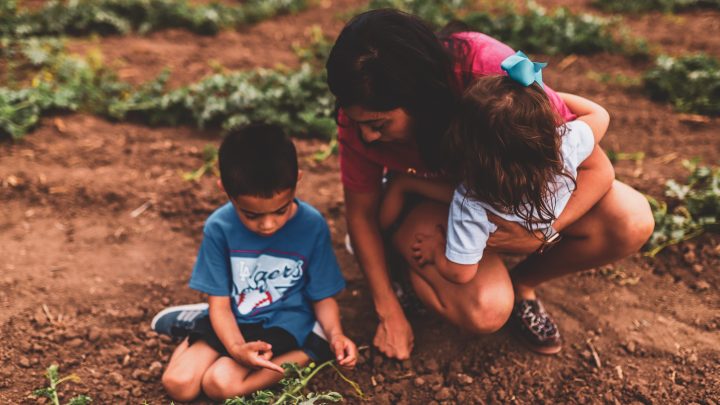
Finding child care is tough for farming families. The next farm bill could help.
Finding child care is tough for farming families. The next farm bill could help.

Gracie and Cayden Viramontes are fourth-generation New Mexico farm kids. Their family grows cotton, onions, pecans, pumpkins and the state’s signature green chiles on about 500 acres in Deming, where Gracie and Cayden spend a lot of their time learning what it takes to produce those crops.
“And the seed and the lint both have a purpose, right?” asks their mom, Jamie Viramontes, during a winter afternoon farm walk at the tail end of the cotton season. “What does cotton make?”
“Underwear!” 6-year-old Gracie said.
“And it makes your clothes, and your shirt and your pants,” 8-year-old Cayden added.
Ever since they became parents, Jamie and Cole Viramontes have been taking their kids to work.
“A lot of times I had a baby on my hip, and I was walking around the watermelon shed helping make sure things were flowing smoothly,” Jamie said. “We set up a playroom in my office where they could play and watch TV and take naps.” Though naptime was tough to pull off on a noisy worksite.
Back before their kids were old enough to go to school, Jamie and Cole would cobble together child care solutions during the farm’s busy seasons. A few hours with a babysitter here and a favor from a family member there would help them focus on their work. But dropping the kids at one of the few child care centers in rural Deming was never really an option.
“They cater to normal, Monday-through-Friday, 9-to-5 hours,” and Jamie said the demands of farm work aren’t predictable or consistent. “The majority of day cares are not open until 11, 12 o’clock at night. So if you’re running a produce-packing facility and you’re shipping out trucks, you’re not going to have a lot of options.”
Jamie said Gracie and Cayden mostly enjoyed tagging along with their working parents, and she’s glad they’ve experienced day-to-day farm operations.

“But it’s not always an easy option,” she said. “It takes you 10 times longer to do any task, and it’s definitely much harder.”
Three-quarters of farming families have trouble finding child care because of cost, distance to care or scheduling incompatibility, according to research by Shoshanah Inwood, a rural sociologist at Ohio State University.
“When we talk about farm profitability and farm viability, these issues of child care are often absent from the conversation,” she said.
Even though most American farms are family businesses, Inwood said agriculture has been slow to acknowledge how those child care issues impact individual farmers’ bottom lines and destabilize the whole sector.
“In fact, they’re often the elephant in the room,” she said.
Maybe not for long. For the first time, two influential farm lobbies have made expanding child care access in rural areas an official priority for the next farm bill.
“With the average age of a farmer being 58, that’s not necessarily young,” said Layla Soberanis with the National Farmers Union. She said the new attention on rural child care access is also about “empowering women to be a part of decision making and be a part of farming,” rather than assuming they’ll focus on child care on the family farm.
With support from the National Farmers Union, the American Farm Bureau Federation and lawmakers from both parties, the Expanding Childcare in Rural America Act is expected to be included in the next farm bill. That legislation would make loans and grants available through the U.S. Department of Agriculture’s rural development funds to help child care centers improve their facilities and hire and train more staff.
“If that gets put into the farm bill, that is, I think, a very important and encouraging change,” said Adam Alson, who farms corn and soybeans in northwest Indiana.
Alson also runs Appleseed Childhood Education, a nonprofit that funds his rural town’s only early learning center. With federal support, Alson said Appleseed could expand hours and capacity to better serve farming families and potentially open more child care centers in the region.
“We view it as infrastructure, right? We view it like having broadband, we view it like having a strong health care system,” Alson said.
Without quality, affordable child care options, Jamie Viramontes said many young people won’t have the option of staying in their rural communities.
“We as entrepreneurs are trying our hardest to continue carrying on this legacy of the farm,” Jamie Viramontes said.
Depending on when a farm bill is passed, federal help may not come too late for the Viramontes family. They’re sorting out the child care puzzle all over again, with their newest farm kid due at the end of January.
There’s a lot happening in the world. Through it all, Marketplace is here for you.
You rely on Marketplace to break down the world’s events and tell you how it affects you in a fact-based, approachable way. We rely on your financial support to keep making that possible.
Your donation today powers the independent journalism that you rely on. For just $5/month, you can help sustain Marketplace so we can keep reporting on the things that matter to you.

















